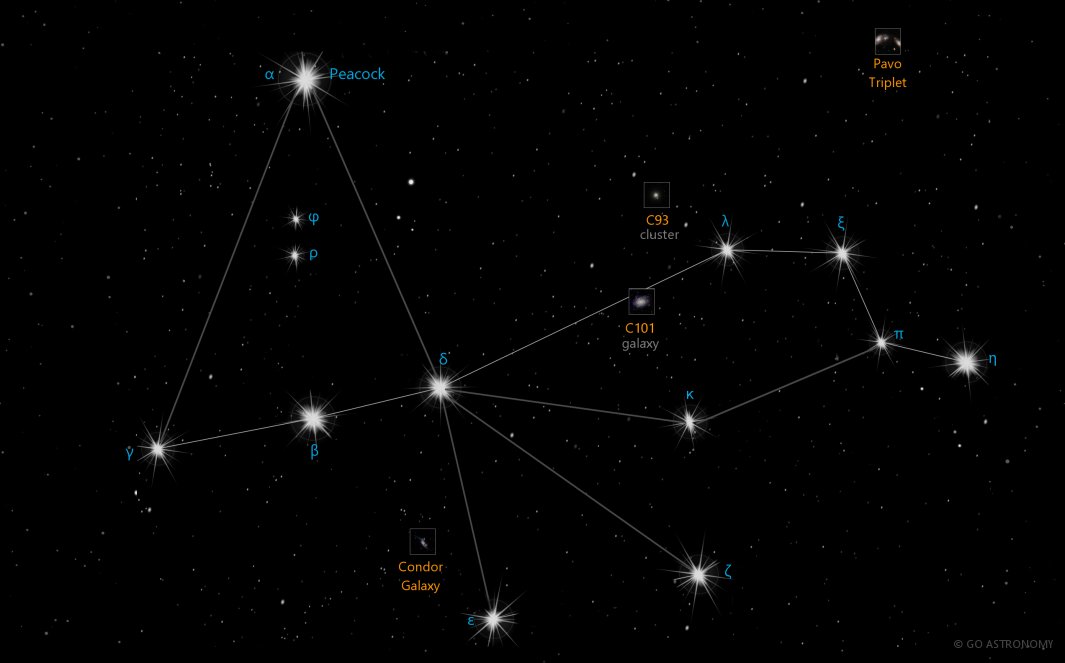Pavo, the Peacock (Pav)
(PAY-vo)
The Southern constellation of Pavo, the Peacock, is best viewed in Fall during the month of September.
Pavo is the 44th largest constellation. It's brightest star is Peacock at magnitude 1.91. The boundary of the Pavo constellation contains 7 stars that host known exoplanets.
Pavo is a circumpolar constellation, so is visible year-round in the Southern hemisphere. Conversely, it is not visible in the opposite hemisphere.
- Pronunciation:
- PAY-vo
- Meaning:
- Peacock
- Genitive:
- Pavonis
- Abbreviation:
- Pav
- Constellation Family:
- Bayer
- Hemisphere:
- Southern
- Quadrant:
- SQ4
- Visibility:
- 30° N - 90° S
- Best viewing month*:
- September
- Area:
- 378 sq. degrees
- Size:
- 44th largest
- Circumpolar** (N=northern, S=southern):
- S circumpolar
- Right Ascension (avg):
- 19h 10m
- Declination (avg):
- -65°
- Brightest star:
- Peacock (1.91)
- Stars with planets:
- 7
- Messier objects:
- |
Brightest Stars in Pavo
The 10 brightest stars in the constellation Pavo by magnitude.
- Star
- Magnitude
- Spectral class
- Alpha Pavonis (α Pav)
- 1.94
- B2IV
- Beta Pavonis (β Pav)
- 3.42
- A5IV
- Delta Pavonis (δ Pav)
- 3.55
- G5IV-Vvar
- Eta Pavonis (η Pav)
- 3.61
- K1III
- Epsilon Pavonis (ε Pav)
- 3.97
- A0V
- Zeta Pavonis (ζ Pav)
- 4.01
- K2III
- Gamma Pavonis (γ Pav)
- 4.21
- F6V
- Lambda Pavonis (λ Pav)
- 4.22
- B2II-III
- Pi Pavonis (π Pav)
- 4.33
- Am
- Xi Pavonis (ξ Pav)
- 4.35
- M1III SB
Star Clusters in Pavo
The most notable and easy-to-find star clusters in the constellation Pavo . Also see all star clusters.
Galaxies in Pavo
The most notable galaxies in the constellation Pavo. Also see all galaxies.
- Name
- Alt name
- Type
- Caldwell 101
- C101
- spiral
- Condor Galaxy
- spiral
- NGC 7020
- ring
- Pavo Triplet
- galaxy group
The Peacock of the Sky
Pavo, Latin for peacock, is a small and faint constellation located in the southern sky. First introduced by Dutch astronomers Pieter Dirkszoon Keyser and Frederick de Houtman in the late 16th century, it is now one of the 88 constellations recognized by the International Astronomical Union (IAU).
Historical Overview
Although not visible to the ancient Greeks and Romans due to its southern latitude, Pavo first appeared on a celestial globe published by Petrus Plancius in 1598, along with eleven other new constellations. It has since been included in Johann Bayer's "Uranometria" in 1603, one of the most significant early star atlases.
Location and Main Features
Pavo is nestled between Telescopium to the east, Apus and Ara to the south, and Indus to the west. It has an area of 378 square degrees, making it the 44th largest constellation in the sky.
Main Stars in Pavo
Alpha Pavonis, also known as Peacock, is the brightest star in the constellation. A blue-white giant star located around 183 light-years from Earth, it has an apparent magnitude of 1.94. The second brightest, Beta Pavonis, is a yellow giant star with an apparent magnitude of 3.42 located approximately 140 light-years away. Delta Pavonis, a nearby Sun-like star only 19.9 light-years from Earth, is also worth mentioning due to its similarity to our own Sun.
Deep Sky Objects
Despite its small size and faint stars, Pavo is home to several notable deep-sky objects. NGC 6752, one of the brightest globular clusters in the sky, can be observed in this constellation. Another is the barred spiral galaxy IC 4662, a starburst galaxy where intense star formation is taking place.
NGC 6744, a spiral galaxy that closely resembles the Milky Way, is also found in Pavo. This galaxy, although faint and requiring a large telescope to observe clearly, is considered one of the most beautiful extragalactic sights in the sky.
Observation
Pavo is best viewed from southern latitudes during the months of July to September. The constellation's relatively faint stars mean that darker skies away from city lights will provide the best viewing conditions. While the primary stars can be seen with the naked eye, exploration of the constellation's deep-sky objects will require at least a small telescope.
* Constellation shown for northen hemisphere skies. For the southern hemisphere, constellations appear rotated 180 degrees (upside-down and left-right reversed) from what is shown. Remember that seasons are reversed too - summer in northern latitudes is winter in southern latitudes.
** Circumpolar constellations are visible year-round in the hemisphere listed (and not at all in the opposite hemisphere).





